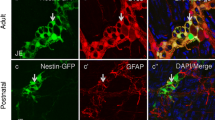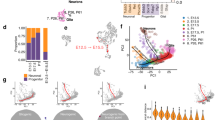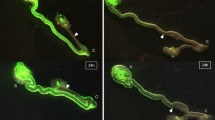Abstract
Neural crest cells that originate in the caudal hindbrain migrate into and along the developing gastrointestinal tract to form the enteric nervous system. While they are migrating, neural-crest-derived cells are also proliferating. Previous studies have shown that the expression of glial-derived neurotrophic factor (GDNF) and endothelin-3 is highest in the embryonic caecum, and that GDNF alone or in combination with endothelin-3 promotes the proliferation of enteric neural-crest-derived cells in vitro. However, whether neural proliferative zones, like those in the central nervous system, are found along the developing gut is unknown. We used a fluorescent nucleic acid stain to identify dividing cells or BrdU labelling (2 h after administration of BrdU to the mother), combined with antibodies specific to neural crest cells to determine the percentage of proliferating crest-derived cells in various gut regions of embryonic day 11.5 (E11.5) and E12.5 mice. The rate of proliferation of crest-derived cells did not vary significantly in different regions of the gut (including the caecum) or at different distances from the migratory wavefront of vagal crest-derived cells. The phenotype of mitotic enteric crest-derived cells was also examined. Cells expressing the pan-neuronal markers, neurofilament-M and Hu, or the glial marker, S100b, were observed undergoing mitosis. However, no evidence was found for proliferation of cells expressing neuron-type-specific markers, such as nitric oxide synthase (at E12.5) or calcitonin gene-related peptide (at E18.5). Thus, for enteric neurons, exit from the cell cycle appears to occur after the expression of pan-neuronal proteins but prior to the expression of markers of terminally differentiated neurons.


Similar content being viewed by others
References
Baetge G, Gershon MD (1989) Transient catecholaminergic (TC) cells in the vagus nerves and bowel of fetal mice: relationship to the development of enteric neurons. Dev Biol 132:189–211
Baetge G, Pintar JE, Gershon MD (1990) Transiently catecholaminergic (TC) cells in the bowel of the fetal rat: precursors of noncatecholaminergic enteric neurons. Dev Biol 141:353–380
Barlow A, Graaff E de, Pachnis V (2003) Enteric nervous system progenitors are coordinately controlled by the G protein-coupled receptor EDNRB and the receptor tyrosine kinase RET. Neuron 40:905–916
Baynash AG, Hosoda K, Giaid A, Richardson JA, Emoto N, Hammer RE, Yanagisawa M (1994) Interaction of endothelin-3 with endothelin-B receptor is essential for development of epidermal melanocytes and enteric neurons. Cell 79:1277–1285
Branchek TA, Gershon MD (1989) Time course of expression of neuropeptide Y, calcitonin gene-related peptide, and NADPH diaphorase activity in neurons of the developing murine bowel and the appearance of 5-hydroxytryptamine in mucosal enterochromaffin cells. J Comp Neurol 285:262–273
Brookes SJ (2001) Classes of enteric nerve cells in the guinea-pig small intestine. Anat Rec 262:58–70
Burns AJ, Le Douarin NM (1998) The sacral neural crest contributes neurons and glia to the post-umbilical gut: spatiotemporal analysis of the development of the enteric nervous system. Development 125:4335–4347
Cacalano G, Farinas I, Wang LC, Hagler K, Forgie A, Moore M, Armanini M, Phillips H, Ryan AM, Reichardt LF, Hynes M, Davies A, Rosenthal A (1998) GFRalpha1 is an essential receptor component for GDNF in the developing nervous system and kidney. Neuron 21:53–62
Chalazonitis A, Rothman TP, Chen J, Gershon MD (1998) Age-dependent differences in the effects of GDNF and NT-3 on the development of neurons and glia from neural crest-derived precursors immunoselected from the fetal rat gut: expression of GFRalpha-1 in vitro and in vivo. Dev Biol 204:385–406
Enomoto H, Araki T, Jackman A, Heuckeroth RO, Snider WD, Johnson EM Jr, Milbrandt J (1998) GFR alpha1-deficient mice have deficits in the enteric nervous system and kidneys. Neuron 21:317–324
Epstein ML, Poulsen KT (1991) Appearance of somatostatin and vasoactive intestinal peptide along the developing chicken gut. J Comp Neurol 311:168–178
Fairman CL, Clagett-Dame M, Lennon VA, Epstein ML (1995) Appearance of neurons in the developing chick gut. Dev Dyn 204:192–201
Focke PJ, Schiltz CA, Jones SE, Watters JJ, Epstein ML (2001) Enteric neuroblasts require the phosphatidylinositol 3-kinase pathway for GDNF-stimulated proliferation. J Neurobiol 47:306–317
Focke PJ, Swetlik AR, Schilz JL, Epstein ML (2003) GDNF and insulin cooperate to enhance the proliferation and differentiation of enteric crest-derived cells. J Neurobiol 55:151–164
Furness JB (2000) Types of neurons in the enteric nervous system. J Auton Nerv Syst 81:87–96
Gariepy CE (2001) Intestinal motility disorders and development of the enteric nervous system. Pediatr Res 49:605–613
Gershon MD (1997) Genes and lineages in the formation of the enteric nervous system. Curr Opin Neurobiol 7:101–109
Gianino S, Grider JR, Cresswell J, Enomoto H, Heuckeroth RO (2003) GDNF availability determines enteric neuron number by controlling precursor proliferation. Development 130:2187–2198
Hearn CJ, Murphy M, Newgreen D (1998) GDNF and ET-3 differentially modulate the numbers of avian enteric neural crest cells and enteric neurons in vitro. Dev Biol 197:93–105
Heuckeroth RO (2003) Finding your way to the end. A tale of GDNF and endothelin-3. Neuron 40:871–873
Heukeroth RO, Lampe PA, Johnson EM, Milbrandt J (1998) Neurturin and GDNF promote proliferation and survival of enteric neuron and glial progenitors in vitro. Dev Biol 200:116–129
Hosoda K, Hammer RE, Richardson JA, Baynash AG, Cheung JC, Giaid A, Yanagisawa M (1994) Targeted and natural (piebald-lethal) mutations of endothelin-B receptor gene produce megacolon associated with spotted coat color in mice. Cell 79:1267–1276
Iwashita T, Kruger GM, Pardal R, Kiel MJ, Morrison SJ (2003) Hirschsprung disease is linked to defects in neural crest stem cell function. Science 301:972–976
Kapur RP (2000) Colonization of the murine hindgut by sacral crest-derived neural precursors: experimental support for an evolutionarily conserved model. Dev Biol 227:146–155
Kapur RP, Yost C, Palmiter RD (1992) A transgenic model for studying development of the enteric nervous system in normal and aganglionic mice. Development 116:167–175
Kapur RP, Yost C, Palmiter RD (1993) Aggregation chimeras demonstrate that the primary defect responsible for aganglionic megacolon in lethal spotted mice is not neuroblast autonomous. Development 117:993–999
Kapur RP, Sweetser DA, Doggett B, Siebert JR, Palmiter RD (1995) Intercellular signals downstream of endothelin receptor-B mediate colonization of the large intestine by enteric neuroblasts. Development 121:3787–3795
Kruger GM, Mosher JT, Tsai YH, Yeager KJ, Iwashita T, Gariepy CE, Morrison SJ (2003) Temporally distinct requirements for endothelin receptor B in the generation and migration of gut neural crest stem cells. Neuron 40:917–929
Le Douarin NM, Teillet MA (1973) The migration of neural crest cells to the wall of the digestive tract in avian embryo. J Embryol Exp Morphol 30:31–48
Lee HO, Levorse JM, Shin MK (2003) The endothelin receptor-B is required for the migration of neural crest-derived melanocyte and enteric neuron precursors. Dev Biol 259:162–175
Leibl MA, Ota T, Woodward MN, Kenny SE, Lloyd DA, Vaillant CR, Edgar DH (1999) Expression of endothelin 3 by mesenchymal cells of embryonic mouse caecum. Gut 44:246–252
Lin Z, Gao N, Hu HZ, Liu S, Gao C, Kim G, Ren J, Xia Y, Peck OC, Wood JD (2002) Immunoreactivity of Hu proteins facilitates identification of myenteric neurones in guinea-pig small intestine. Neurogastroenterol Motil 14:197–204
Miyata T, Kawaguchi A, Okano H, Ogawa M (2001) Asymmetric inheritance of radial glial fibers by cortical neurons. Neuron 31:727–741
Moore MW, Klein RD, Farinas I, Sauer H, Armanini M, Phillips H, Reichardt LF, Ryan AM, Carver-Moore K, Rosenthal A (1996) Renal and neuronal abnormalities in mice lacking GDNF. Nature 382:76–79
Natarajan D, Marcos-Gutierrez C, Pachnis V, de Graaff E (2002) Requirement of signalling by receptor tyrosine kinase RET for the directed migration of enteric nervous system progenitor cells during mammalian embryogenesis. Development 129:5151–5160
Newgreen D, Young HM (2002) Enteric nervous system: development and developmental disturbances-part 1. Pediatr Dev Pathol 5:224–247
Norris PJ, Charles IG, Scorer CA, Emson PC (1995) Studies on the localization and expression of nitric oxide synthase using histochemical techniques. Histochem J 27:745–756
Pattyn A, Morin X, Cremer H, Goridis C, Brunet JF (1999) The homeobox gene Phox2b is essential for the development of autonomic neural crest derivatives. Nature 399:366–370
Payette RF, Bennett GS, Gershon MD (1984) Neurofilament expression in vagal neural crest-derived precursors of enteric neurons. Dev Biol 105:273–287
Pichel JG, Shen L, Sheng HZ, Granholm AC, Drago J, Grinberg A, Lee EJ, Huang SP, Saarma M, Hoffer BJ, Sariola H, Westphal H (1996) Defects in enteric innervation and kidney development in mice lacking GDNF. Nature 382:73–76
Rohrer H, Thoenen H (1987) Relationship between differentiation and terminal mitosis: chick sensory and ciliary neurons differentiate after terminal mitosis of precursor cells, whereas sympathetic neurons continue to divide after differentiation. J Neurosci 7:3739–3748
Rohrer H, Henke-Fahle S, el-Sharkawy T, Lux HD, Thoenen H (1985) Progenitor cells from embryonic chick dorsal root ganglia differentiate in vitro to neurons: biochemical and electrophysiological evidence. EMBO J 4:1709–1714
Rohrer H, Acheson AL, Thibault J, Thoenen H (1986) Developmental potential of quail dorsal root ganglion cells analyzed in vitro and in vivo. J Neurosci 6:2616–2624
Rothman TP, Gershon MD, Holtzer H (1978) The relationship of cell division to the acquisition of adrenergic characteristics by developing sympathetic ganglion cell precursors. Dev Biol 65:322–341
Sanchez MP, Silos-Santiago I, Frisen J, He B, Lira SA, Barbacid M (1996) Renal agenesis and the absence of enteric neurons in mice lacking GDNF. Nature 382:70–73
Sang Q, Young HM (1996) Chemical coding of neurons in the myenteric plexus and external muscle of the small and large intestine of the mouse. Cell Tissue Res 284:39–53
Sang Q, Young HM (1998) The identification and chemical coding of cholinergic neurons in the small and large intestine of the mouse. Anat Rec 251:185–199
Schuchardt A, D’Agati V, Larsson-Blomberg L, Costantini F, Pachnis V (1994) Defects in the kidney and enteric nervous system of mice lacking the tyrosine kinase receptor Ret. Nature 367:380–383
Shen Q, Zhong W, Jan YN, Temple S (2002) Asymmetric numb distribution is critical for asymmetric cell division of mouse cerebral cortical stem cells and neuroblasts. Development 129:4843–4853
Shin MK, Levorse JM, Ingram RS, Tilghman SM (1999) The temporal requirement for endothelin receptor-B signalling during neural crest development. Nature 402:496–501
Sidebotham EL, Woodward MN, Kenny SE, Lloyd DA, Vaillant CR, Edgar DH (2001) Assessment of protein gene product 9.5 as a marker of neural crest-derived precursor cells in the developing enteric nervous system. Pediatr Surg Int 17:304–307
Sidebotham EL, Kenny SE, Lloyd DA, Vaillant CR, Edgar DH (2002) Location of stem cells for the enteric nervous system. Pediatr Surg Int 18:581–585
Stewart AL, Anderson RB, Young HM (2003) Characterization of lacZ-expressing cells in the gut of embryonic and adult DbH-nlacZ mice. J Comp Neurol 464:208–219
Stofer WD, Horn JP (1993) Neurogenesis and differentiation of sympathetic B and C cells in the bullfrog tadpole. J Neurosci 13:801–807
Taraviras S, Pachnis V (1999) Development of the mammalian enteric nervous system. Curr Opin Genet Dev 9:321–327
Taraviras S, Marcos-Gutierrez CV, Durbec P, Jani H, Grigoriou M, Sukumaran M, Wang LC, Hynes M, Raisman G, Pachnis V (1999) Signalling by the RET receptor tyrosine kinase and its role in the development of the mammalian enteric nervous system. Development 126:2785–2797
Teitelman G, Gershon MD, Rothman TP, Joh TH, Reis DJ (1981) Proliferation and distribution of cells that transiently express a catecholaminergic phenotype during development in mice and rats. Dev Biol 86:348–355
Tomac AC, Grinberg A, Huang SP, Nosrat C, Wang Y, Borlongan C, Lin SZ, Chiang YH, Olson L, Westphal H, Hoffer BJ (2000) Glial cell line-derived neurotrophic factor receptor alpha1 availability regulates glial cell line-derived neurotrophic factor signaling: evidence from mice carrying one or two mutated alleles. Neuroscience 95:1011–1023
Waid DK, McLoon SC (1995) Immediate differentiation of ganglion cells following mitosis in the developing retina. Neuron 14:117–124
Wolf E, Black IB, DiCicco-Bloom E (1999) Mitotic sympathetic neuroblasts initiate axonal pathfinding in vivo. J Neurobiol 40:366–374
Woodward MN, Kenny SE, Vaillant C, Lloyd DA, Edgar DH (2000) Time-dependent effects of endothelin-3 on enteric nervous system development in an organ culture model of Hirschsprung’s disease. J Pediatr Surg 35:25–29
Worley DS, Pisano JM, Choi ED, Walus L, Hession CA, Cate RL, Sanicola M, Birren SJ (2000) Developmental regulation of GDNF response and receptor expression in the enteric nervous system. Development 127:4383–4393
Wu JJ, Chen JX, Rothman TP, Gershon MD (1999) Inhibition of in vitro enteric neuronal development by endothelin-3: mediation by endothelin B receptors. Development 126:1161–1173
Yntema CL, Hammond WS (1954) The origin of intrinsic ganglia of trunk viscera from vagal neural crest in the chick embryo. J Comp Neurol 101:515–541
Young HM, Newgreen D (2001) Enteric neural crest-derived cells: origin, identification, migration, and differentiation. Anat Rec 262:1–15
Young HM, Hearn CJ, Farlie PG, Canty AJ, Thomas PQ, Newgreen DF (2001) GDNF is a chemoattractant for enteric neural cells. Dev Biol 229:503–516
Young HM, Jones BR, McKeown SJ (2002) The projections of early enteric neurons are influenced by the direction of neural crest cell migration. J Neurosci 22:6005–6018
Young HM, Bergner AJ, Müller T (2003) Acquisition of neuronal and glial markers by neural crest-derived cells in the mouse intestine. J Comp Neurol 456:1–11
Young HM, Bergner AJ, Anderson RB, Enomoto H, Milbrandt J, Newgreen DF, Whitington PM (2004) Dynamics of neural crest-derived cell migration in the embryonic mouse gut. Dev Biol 270:455–473
Zhu L, Lee HO, Jordan CS, Cantrell VA, Southard-Smith EM, Shin MK (2004) Spatiotemporal regulation of endothelin receptor-B by SOX10 in neural crest-derived enteric neuron precursors. Nat Genet 36:732–737
Acknowledgements
We thank Dr. Vicki Hammond for advice on BrdU labelling and Drs. Piers Emson, Jean Francois Brunet and Miles Epstein for the provision of antisera.
Author information
Authors and Affiliations
Corresponding author
Additional information
This work was supported by the Australian Research Council (DP0345298) and the National Health and Medical Research Council of Australia (Project grant 145628 and Senior Research Fellowship 170224).
Rights and permissions
About this article
Cite this article
Young, H.M., Turner, K.N. & Bergner, A.J. The location and phenotype of proliferating neural-crest-derived cells in the developing mouse gut. Cell Tissue Res 320, 1–9 (2005). https://doi.org/10.1007/s00441-004-1057-5
Received:
Accepted:
Published:
Issue Date:
DOI: https://doi.org/10.1007/s00441-004-1057-5




